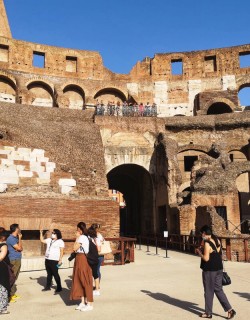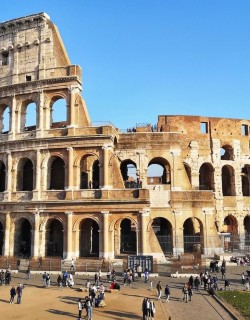Pizza, pasta, panini, gelato, tiramisu, espresso, cappuccino…Italy has always been famous for its food, so it’s not surprising that so many of the Italian words that have entered the English language are food-related. Of course, English speakers often get it wrong, making Italians cringe by saying “expresso”, or asking for “two paninis”. I grew up pronouncing fusilli so incorrectly that I still hesitate when ordering it in restaurants in Rome.
For an education in Italian food – or rather, Roman food, as every city and region has different specialities – visit Testaccio. This is the neighbourhood where I’ve been living for the past two and a half years, eating some of the best food that Rome has to offer, from thin and crispy Roman pizza to creamy gelato.
As local food blogger Rachel Roddy observes, the neighbourhood of Testaccio is shaped a bit like a wedge of cheese – a good chunk of parmigiano or pecorino. One edge curves alongside the river, while another boundary is defined by Via Marmorata, the street that separates Testaccio from the Aventine Hill. The southern side is marked by the Protestant Cemetery and the Pyramid of Cestius, as well as the famous Monte dei Cocci – an artificial hill formed of shards of broken Roman pottery. Visit one of the bars or restaurants along the base of the hill; if you peer through one of the back windows you’ll see the shards piled up next to the glass.
Broken amphorae aside, Testaccio is best known for its food. The mattatoio (abattoir) was built in 1888 and supplied meat to Rome’s restaurants for nearly a hundred years. Now it’s become a symbol of Testaccio’s modern transformation and, some would argue, gentrification. The ex-mattatoio is home to an art gallery, MACRO, and hosts markets, music festivals and cultural events.
But while there’s no longer slaughter in the slaughterhouse, meat-lovers won’t go hungry in Testaccio. Typical meaty pasta dishes include amatriciana (guanciale, tomato and pecorino), carbonara (bacon, egg and pecorino), while saltimbocca alla romana (veal and ham), trippa (tripe) and coda alla vaccinara (oxtail stew) are also popular. You’ll find these dishes at any of the traditional restaurants in Testaccio, and get to sample some of the best on a food tour.
If you’re a vegetarian, don’t despair. Romans love their meat, but they love their vegetables too. Try carciofi alla romana (artichokes) or a side order of cicoria ripassata (chicory with garlic and chilli). Puntarelle is a winter treat, a delicious chicory salad with anchovy and garlic sauce. Then there are the pasta dishes, such as my personal obsession, cacio e pepe (pecorino cheese and pepper), or the speciality at one Testaccio trattoria, fettuccine with truffle and mushrooms.
Naples may be known as the home of pizza, but many people prefer the Roman variety, which is lighter and crispier. For the authentic experience, try a pizzeria in Testaccio. Even if you have starters such as suppli (fried rice balls with mozzarella) or fiori di zucca (fried courgette flowers) before your pizza, you’ll finish your meal pleasantly full, rather than stuffed.
A highlight of the Testaccio food tour is the market, where locals come to buy their fruit and vegetables, and pizza bianca fresh from the oven. Another Testaccio institution is Volpetti, a delicatessen which has been selling the finest meats and cheeses – as well as pasta, pizza, olives, truffles and chocolates – since 1973.
If you want to eat like a Roman, join our Testaccio tour, where you’ll eat some of the best pasta, cheese and meat in Rome, and get a taste of some traditional gelato. And of course, no day in Italy would be complete without an invigorating espresso or a creamy cappuccino. After a proper Italian coffee, you’ll never want to go to Starbucks again…
~by Alexandra Turney~



